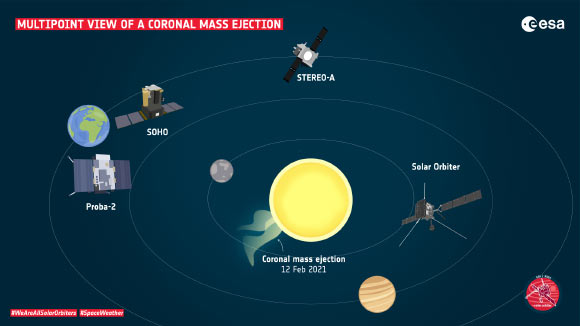
Solar Orbiter Observes Two Huge Eruptions on Sun | Astronomy, Space Exploration
The Extreme Ultraviolet Imager (EUI), the Heliospheric Imager (SoloHI) and the Metis coronagraph onboard the ESA/NASA Solar Orbiter captured different aspects of two coronal mass ejections that erupted on February 12, 2021.Solar Orbiter is a collaborative mission between the ESA and NASA to study our Sun.The spacecraft will view some of the never-before-seen regions of the Sun, including the poles, and shed new light on some of the little understood aspects of the stars activity, such as the formation of the solar wind. It will also provide data about the Suns magnetic field and how it arises.Launched on February 10, 2020, it carries ten scientific instruments, four of which measure properties of the environment around the spacecraft, especially electromagnetic characteristics of the solar wind, the stream of charged particles flowing from the Sun.Solar Orbiter is currently in cruise phase ahead of the main science mission, which begins November this year.The operation of its six remote sensing instruments during cruise phase is focused primarily on instrument calibration, and they are only active during dedicated checkout windows and specific campaigns.A close perihelion pass of the Sun on February 10, 2021, which took Solar Orbiter within half the distance between Earth and our star, was one such opportunity for the spacecraft to carry out dedicated observations, checking instrument settings and so on, in order to best prepare for the upcoming science phase.In full science mode, the remote sensing and in situ instruments will routinely make joint observations together.Sketch of the relative positions of NASAs and ESAs spacecraft that observed the February 12, 2021 coronal mass ejections; ESAs Solar Orbiter spacecraft was behind the Sun from the perspective of Earth; the Earth was about 12 degrees west of Sun-center as seen from Solar Orbiter; ESAs Proba-2, which orbits the Earth, and the ESA/NASA Solar and Heliospheric Observatory (SOHO), which is located in orbit around the Lagrange point 1, 1.5 million km in front of the Earth towards the Sun, also viewed the coronal mass ejection; NASAs STEREO-A (Solar Terrestrial Relations Observatory) also caught a glimpse of the event from its viewpoint away from the direct Sun-Earth line; together the spacecraft provide valuable, different perspectives on the same event. Image credit: ESA.By happy coincidence, three of Solar Orbiters remote sensing instruments captured a pair of coronal mass ejections in the days after closest approach.The mass ejections were also seen by ESAs Proba-2 and the ESA/NASA Solar and Heliospheric Observatory (SOHO) from the front side of the Sun, while NASAs STEREO-A, located away from the Sun-Earth line, also caught a glimpse, together providing a global view of the events.For Solar Orbiters SoloHI, this was the first coronal mass ejection seen by the instrument.The Metis instrument previously detected one on January 17, 2021, and EUI detected one in November 2020, while the spacecrafts in situ detectors bagged their first coronal mass ejections soon after launch in April 2020.
……Technology Space
Comments
Leave a comment in Nestia App